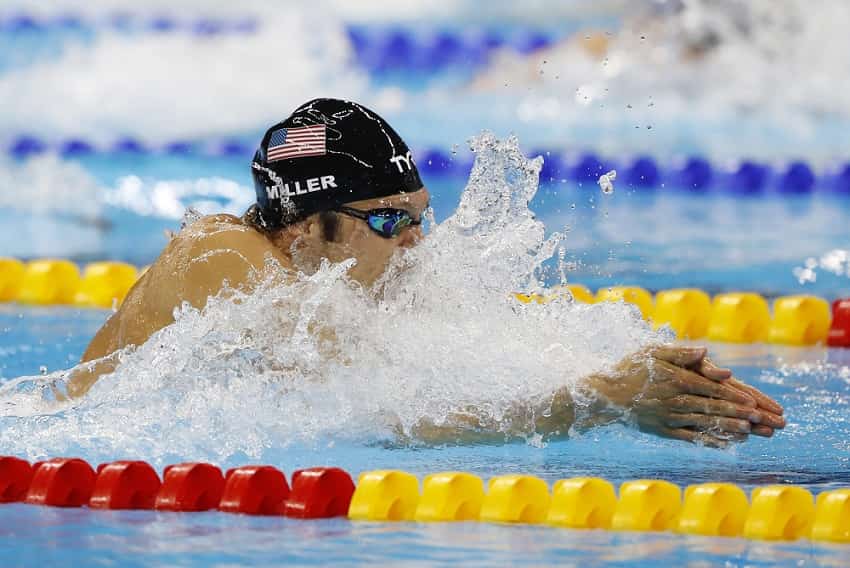A logbook is a simple tool that can build confidence and help swimmers be more focused at practice. Olympian Cody Miller uses his logbook for recognizing wins, building confidence and instilling trust in the process.
Olympic gold medalist breaststroker Cody Miller has been tearing up YouTube with his video channel.
Miller’s videos provide a candid behind-the-scenes of the life of a professional swimmer.
The Olympic gold medalist gives candid advice to swimmers through his Q and A videos, captures the grind of full-time training at Indiana, and sprinkles in non-swimming content such as movie reviews.
In a recent Q and A, Miller answered a question from a fan on whether he writes out his swim practices in a logbook.
He explained that after practice he gets into his car, cracks open a notebook, and writes out the details of the swim workout.
“I log all of my workouts. I log the volume, I log the type of workout we did, I log the sets,” said Miller.
There are a few different things that writing out his workouts in a notebook do for him.
The benefits of keeping a logbook
For starters, it provides a place where he can recognize where he is crushing it and how he can be better.
“It’s like a highlight reel where I write down the highlights of each practice, things I did better, things I could have done better,” says Miller.
This type of self-monitoring, whether it’s grading your effort after practice, or staying on top of your training goals, or evaluating ways you can improve, is a common characteristic of elite athletes.
Becoming a better and faster swimmer is a relentless journey. There are countless things we are trying to improve in the water, from our technique, our starts, our turns, our mobility, and on and on.
Using a logbook can help you become a more self-aware swimmer when it is used for reflection and for plotting what is next.
Elite swimmers learn quicker from their missteps, and a logbook is an ideal place to chart how you are going to come back better tomorrow.
Miller’s logbook is a tool for self-confidence.
In the same way that Missy Franklin used a Confidence Jar before big competitions to remind herself of all the awesome work she had done, Miller uses his logbook as an inventory of epic performances.
Having them there, on paper, serves as a powerful reminder of all the hard work he has done. Flipping through the sets, the workouts, the moments of excellence, that would otherwise get lost to the fog of months of training are there, infusing him with confidence.
“It’s reinforcing the truthful notion that you’ve been making progress,” says Miller. “That you’ve been doing things that are making you better.”
Swimmers often gloss over their achievements in training, preferring to focus on the things that went wrong, the missteps, the failures. This happens especially during times of stress and uncertainty (like the night before a super important meet, ahem).
Self-confidence for swimmers happens when we see a pattern of excellence in what we are doing in the water, and a logbook is a perfect place to keep inventory of those moments.
A logbook gives you confidence in the process.
Doubt and uncertainty ebb and flow over the course of the season. We have a bad workout and wonder if we are getting worse. A competitor bursts through, making us second-guess our preparation and training.
A logbook is more than just a collection of sets and intervals, it’s a reminder to trust in your process.
“I like to have data, I like to have an idea of where I’m at, I like to know,” says Miller. “I think it’s good for building confidence.”
Although Miller uses his logbook as a way to track and evaluate how his training is going, he recognizes that this approach isn’t necessary for everyone. One of his training mates at Indiana, Blake Pieroni, who, by Miller’s estimation, logs little to nothing.
“He just trusts that the plan and the program, that his coach is giving him is working…and that’s good enough for him.”
But for the rest of us, the swimmers who aren’t always brimming with confidence and certainty, having the story of our swimming on paper helps us see the journey for what it is, and not what it feels like.
Logging your workouts for faster swimming.
Miller is not alone among elite swimmers in writing out practices.
Caeleb Dressel jots out detailed notes and thoughts on his swimming in a blank notebook.
Katie Ledecky used a logbook as a tool for opening up communication between herself and her age group coach, Yuri Suguiyama.
And Janet Evans, legendary distance ace, wrote out her swim practices, which helped her reflect on her swimming and keep her motivated.
Curious about starting your own logbook?
There are other guides and posts on the site that detail best practices for logging.














